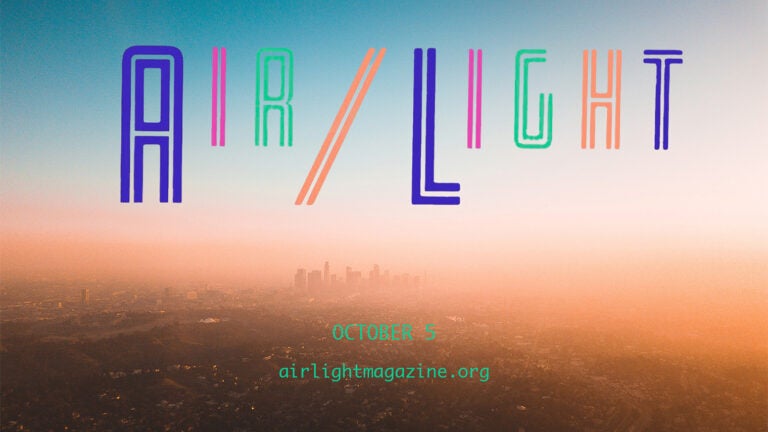
USC Dornsife’s Department of English launches new international literary journal
In Lawrence Weschler’s 1998 New Yorker essay “L.A. Glows,” a climate scientist uses the word “airlight” to describe why Southern California light is sometimes crisp and clear, so everything can be seen with clarity, and sometimes the light is diffused and hazy, so everything seems obfuscated.
From this comes the inspiration for the name of USC’s new international literary journal, Air/Light, published by the Department of English at USC Dornsife College of Letters, Arts and Sciences.
“We were looking for a name that would reflect the complexity of L.A., rather than the kind of false simplicity with which people look at the place,” says David Ulin, associate professor of the practice of English and the editor of Air/Light.
“I think that’s about as great a metaphor that really represents something fundamental about the complexities of the place as I can think of, the way that it sometimes is so confounding and sometimes it’s so clear and the idea that it’s always shifting.”
Launched on Oct. 5, the first issue is packed with new writing from national and international literary stars, including Victoria Chang, longlisted for the 2020 National Book Award in poetry; Natashia Deón, discussing race and policing; Wendy Ortiz, writing on pandemic TV viewing; award-winning young adult author Lilliam Rivera; alumna Susan Straight; and poet Vickie Vertiz.
Not your typical literary journal
Air/Light is the brain child of Ulin, who also teaches within the progressive M.A. degree in literary editing and publishing, and University Professor David St. John, professor of English and comparative literature and chair of the Department of English.
The pair brought on board Aaron Winslow, a postdoctoral researcher in the Department of English with a background in archives and digital preservation, to be Air/Light’s managing editor.
“Two and a half years ago, David, Aaron and I first began meeting and plotting, and imagining what an online journal, not just could be, but should be,” St. John says.
One of the ideas St. John, Ulin and Winslow talked about from the very beginning was creating a magazine that was not about California or the West, but would be a national and international publication with a sensibility firmly rooted inCalifornia and the West.
“I think we often get caught up in that sort of navel gazing exercise of looking at ourselves and trying to explain ourselves, but I’m much more interested in the California point of view and how we build a publication that grows out of, or reflects that perspective,” Ulin says. “I don’t think there are any literary journals that are doing that.”
Ulin, formerly the Los Angeles Times’ book editor and book critic, describes Air/Light as “a 20th-century style literary journal superimposed on 21st-century technology.
“I like the flexibility that the digital landscape gives us to expand the scope of what a literary journal can publish and how we can present that work,” he says.
While retaining many elements of a traditional literary journal, Air/Light will incorporate multimedia and multidisciplinary story telling. For instance, the first issue features a photo diary by Pam Houston and video of a dance piece, “Code – dIsSoNaNcE – REVERIE,” conceived and choreographed by Andre Tyson, with a libretto written and performed by poet Douglas Kearney. The dance video appears alongside Kearney’s text and a separate video conversation in which the poet discusses the project with Tyson.
Video games? Yes, and more!
Air/Light plans to use its digital platform to expand the scope of what a literary journal can publish, even including video games as part of its regular content.
“Many writers and people in the literary world play games, but they don’t often think of narrative gaming in the context of contemporary literary culture,” says Winslow, who also has a background in game writing and development.
The journal will also provide its readers with an easily accessible digital archive.
“Thinking about our archive as a discovery platform makes sense because we will have such a wide variety of work,” Winslow says. “Come for the personal essay on family history, stay for the gothic fiction or the multimedia performance.”
St. John says Air/Light is targeted at curious readers with eclectic interests who are looking to make discoveries, even outside the normal confines of their own taste.
“I would love for a reader to go to an issue to read a poem, say by Lynne Thompson, and suddenly see Pam Houston’s photographs, and then find one of the gaming features,” he says. “I think if readers have the opportunity to move horizontally and then to go deep, it’s ideal.”
The journal will also provide valuable internship opportunities for students in USC Dornsife’s Literary Editing and Publishing program.
Air/Light will appear online quarterly, with the issue’s full table of contents available immediately. Content will be rolled out weekly, however, with new material appearing on the site every Monday.